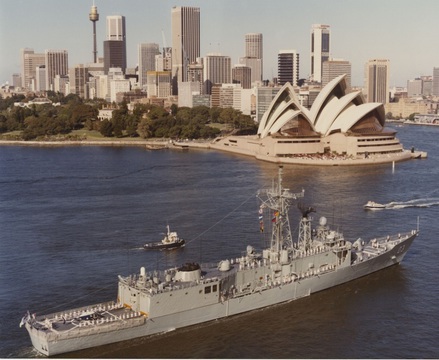
About This Unit
HMAS Sydney (IV)
extract from RAN website
HMAS Sydney (IV) was the third of six Adelaide Class guided missile frigates (FFG) to commission into the Royal Australian Navy (RAN) in the early 1980s. Sydney was built at the Todd Pacific Shipyards in Seattle, Washington, USA, and commissioned there on 29 January 1983 under the command of Commander Paul Kable, RAN. The first four FFGs, HMA Ships Adelaide (II), Canberra (II), Sydney and Darwin, were built in the USA with subsequent modifications undertaken in Australia. The last two, HMA Ships Melbourne (III) and Newcastle, were constructed in Australia with all modifications incorporated.
The Adelaide Class was based upon the US-designed Oliver Hazard Perry Class FFG, the concept for which began in 1971 when the United States Navy (USN) initiated a programme to build 50 patrol frigates. These were later redesignated guided missile frigates designed for long-range escort with roles including air defence, anti-submarine warfare, surveillance, interdiction and reconnaissance. They were capable of countering simultaneous threats from the air, surface and sub-surface. These ships were the first RAN ships to be powered by gas turbine for the main propulsion and could be underway from cold in less than 30 minutes. Two forward mounted, retractable auxiliary propulsion units provided a secondary means of propulsion plus excellent manoeuvrability in confined waters.
Deployments - Middle East 1991
On 14 August 1990 Sydney received a signal instructing her to expedite her return to Australia to prepare for a possible deployment to the Persian Gulf in support of Operation DAMASK. She arrived back in Sydney on 8 September where she commenced a leave and maintenance period.
Sydney returned to sea on 15 October and began an intensive workup programme in preparation for her deployment to the Persian Gulf. She also underwent a number of capability enhancements including new satellite communications equipment, surveillance systems, electronic warfare equipment, new radar absorbent material panels, and improved firefighting and damage control equipment. Her sea boats were also replaced with more robust rigid hull inflatable boats. She departed Sydney on 12 November, in company with HMAS Brisbane, having embarked Prime Minister Bob Hawke for a farewell address that morning.
On 30 November 1990, just before entering the Middle East Area of Operations (MEAO), the ships were advised that the United Nations Security Council had adopted Resolution 678 authorising the use of force against Iraq unless it withdrew from Kuwait by 15 January 1991. On 3 December, Prime Minister Hawke announced that Australian units were allowed to pass through the Strait of Hormuz and enter the Arabian Gulf. Sydney and Brisbane were to form part of the largest grouping of warships seen since the end of World War II. The multi-national Coalition included some 90 warships, more than 100 logistic, amphibious and smaller craft, and 800 aircraft from 15 nations.
Sydney returned to Austraia departing the MEAO on 26 March 1991.
On 14 August Sydney was informed that her South East Asian deployment had been cancelled in lieu of a second deployment to the MEAO in support of Operation DAMASK IV. She departed Sydney on 2 September and arrived in the MEAO, via Darwin and Singapore, on 25 September 1991.
East Timor - 1999
On 25 October, Sydney deployed to East Timor under the auspices of Operation STABILISE, the Australian Defence Force's contribution to the International Force East Timor (INTERFET). She arrived in Dili, in company with HMCS Protecteur, on 4 November and continued on the East Timorese enclave of Oecussi, located on the western side of the island of Timor, the following day.
The naval component of the INTERFET Coalition included units from Australia, the USA, Canada, France, Italy, Portugal, Singapore, New Zealand and Thailand. Sydney's primary mission was the conduct of presence and surveillance in the Oecussi enclave though it quickly became apparent that she would have a significant role to play in supporting the INTERFET forces ashore as well as providing humanitarian support to the local community. She conducted operations off Oecussi for the duration of her deployment provided hotel services to INTERFET personnel, provided meals and other services to INTERFET personnel ashore, conducted eight aeromedical evacuations to Dili using the ship's Seahawk helicopter, expended some 3600 man hours in humanitarian assistance including the provision of medical assistance daily, and loaned personnel to other INTERFET units both afloat and ashore. She departed the Area of Operations on 17 December and arrived back in Sydney, via Darwin, on Christmas Eve, 1991.
After more than 30 year's service, Sydney decommissioned on 7 November 2015 after which she continued to serve as a Harbour Training Ship in Sydney Harbour.
Reference: https://www.navy.gov.au/hmas-sydney-iv-part-4









